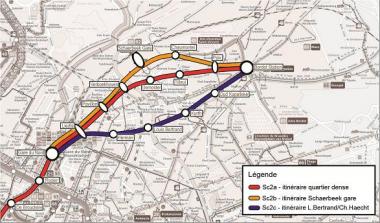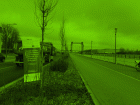
2013-02-28 – The Brussels regional government has today chosen the route of the Métro Nord, the extension of the Brusselsmetro in the direction of Schaerbeekand Evere, on the proposal of the Minister for Public Works and Transport.
The choice has fallen on the ‘Schaerbeekdense’ route (see map). This presents the highest use potential and is the shortest and hence least expensive of the three variants that were considered. The details of the route and the exact position of the metro stations will be determined after consultation with the municipalities of Schaerbeekand Evere. The goal is to begin construction in 2018. The route is scheduled to come into operation by 2022. The project’s total cost will be 570 million euros.
The starting point will be the Gare du Nord. The study that has been carried out assumes that a station will be created every 700 metres. By way of comparison, in Paristhe average distance between two stations is 1 km, but in the current Brusselsmetro it is less than 500 metres. The Brusselsgovernment has decided that the positioning of the stations will need to be chosen in order to optimise connections between the train, tram and bus services. The new line’s terminus has not yet been determined: Bordet and Haren are two possibilities.
The northerly extension of the metro is needed to meet growing demand for public transport between the centre of Brusselsand the north of the Region. This demand has been estimated at more than 6,000 passengers per hour, which is more than can be catered for by improved links with the trams and surface-level metro network. Nor would a ‘premetro’ (underground tramway) be able to cope with this number of passengers. A socio-economic study conducted last autumn revealed that a new northern premetro line would become saturated as soon as it was brought into operation, with an immediate load level of 162%.
Regarding the type of metro line, the study gave preference to an automatic line over a manual one. The investment cost is slightly higher (+4.5%), but the speed, frequency and capacity are greater, resulting in lower operating costs.















